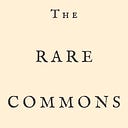Welcome to the Rare Commons - a home for curated tours of the best and brightest in online exhibits and the digital humanities
The Rare Commons is a place to find curated tours of online exhibits based on curiosity, exploration, and discovery. Librarians, archivists, and people working across disciplines in the digital humanities are busy making tools, objects and archives available so that you (yes, YOU) can use them to create new knowledge.
We're bringing you the stories behind the collections, navigating the wealth of rare materials available from the comfort of your own laptop.
Where do you start? Right here.
FAQ
Why is it called the Rare Commons?
Yes, it’s a pun, but more than that, it’s an idea about what rare books and special collections can be, and who they’re for. The proliferation of digitized rare books and special collections available for free online means that they’re more visible than ever before.
I’m interested in empowering people to make use of these free resources, resources held “in common.” However, it’s always important to check on how to use each resource in accordance with copyright. Digital books take many forms, and the institutions that make them available have different guidelines for their use.
What makes rare books rare? What makes special collections special? Am I allowed to be in here?
1. Who knows 2. Beats me 3. Absolutely you are!
Seriously, though, those are questions that librarians and archivists struggle with. One definition might be that special collections are extremely valuable - but valuable to whom, and why?
Items designated this way are usually precious in some way, whether it’s because they’re unique or odd, or made of expensive materials, or particularly fragile or delicate. I tend to think of them as “not easily replaceable”.
It’s important to remember that when items get designated as “rare” and “special” it’s a reflection of what society deems valuable. We’ve got a responsibility to question and interrogate those choices, or at least be thoughtfully, relentlessly curious about them. It’s not a perfect category, but it’s what we’ve got for now.
Where else can I find you?
The Rare Commons is on Twitter and Instagram, and hopefully soon on YouTube and TikTok. For more about me, check out my personal website.
Will the newsletter always be free?
The monthly newsletter is always going to be free, but I’m hoping to expand the subscription model with paid offerings for those of you who just can’t get enough Rare Commons. Nothing will be behind a paywall that you can get for free elsewhere. More to come.
What’s your header image?
This is Plate 18 from Papillons, by Emile-Allain Séguy, a French designer and author who made colorful repeating patterns of insects and plant life using pochoir, a style of hand-painted stencilling used often for posters and visual art at the turn of the 20th century. I chose it because the University of Illinois at Urbana-Champaign holds a copy of another series of his plates that was one of my very favorite items when I was in library school. It’s totally worth seeing in person if you’re in town.
The original image is from the Biodiversity Heritage Library website, originally donated by the Smithsonian Libraries. Find it here: Séguy, E. A. (Emile-Allain). Papillons. Paris: Tolmer, 1925. https://www.biodiversitylibrary.org/item/192166. https://doi.org/10.5962/bhl.title.109786
I have more questions you haven’t answered here!
Don’t hesitate to get in touch!
Stay up-to-date
You won’t have to worry about missing anything. Every new edition of the newsletter goes directly to your inbox.
Subscribe to get full access to the newsletter and website. Never miss an update.
Join the crew
Be part of a community of people who share your interests.
To find out more about the company that provides the tech for this newsletter, visit Substack.com.

